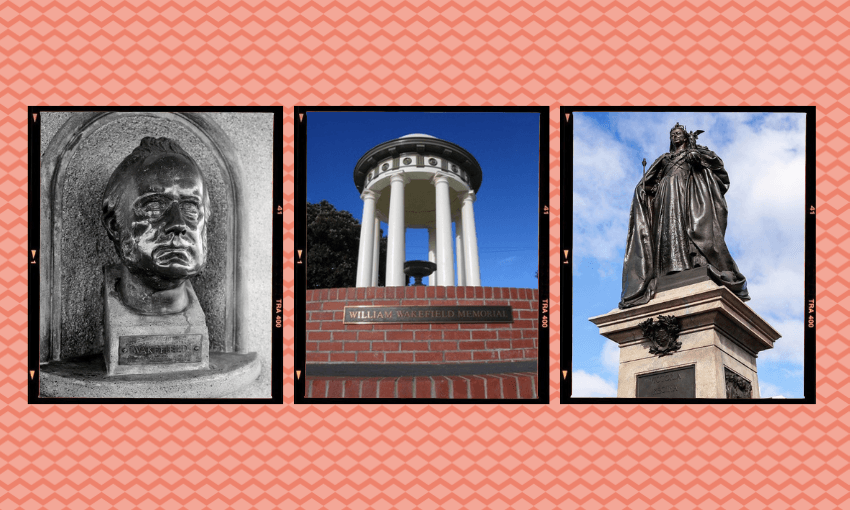The memorials to controversial figures like William and Edward Wakefield play an important role in understanding the city’s complex origins.
Each morning, on my way to work, I stroll through Bolton Street Cemetery. It’s an idyllic setting, in the green cocoon of the Botanical Gardens, with a soundtrack of shrieking kākā.
Walking through a cemetery might seem like a depressing way to start the day, but it’s not. Because the graves are so old, they’re less of a tragedy and more of a historical curiosity. There are gravestones for two signatories of Te Tiriti o Waitangi, Te Ropiha Moturoa and Rīrā Pōrutu, an enormous obelisk for prime minister Richard Seddon, and a disarmingly sexy naked statue of Labour Party leader Harry Holland.
In my opinion, the most interesting grave site is found in the lower part of the cemetery, behind the Ministry of Education building. Four marble stones, laid flat, surrounded by high iron railings. The tomb of Edward Gibbon Wakefield, his brothers William and Daniel, and Daniel’s daughter Selina. The Wakefields are fascinating and controversial figures, and understanding them is key to understanding how Wellington and New Zealand came to be.
As the founders of the New Zealand Company, the Wakefield brothers established the cities of Wellington, Nelson, Whanganui, New Plymouth, Christchurch and Dunedin. The company brought 14,000 settlers to New Zealand, mostly working class labourers and their families who were offered free passage to the new colony. At a conservative estimate, those people would have at least half a million descendants today (including me).
Wellington Central MP Tamatha Paul recently called for heritage status to be removed from monuments to “thieving criminal colonisers” – specifically the William Wakefield monument in the Basin Reserve, the bronze bust of Edward Gibbon Wakefield on Mt Victoria, and the Queen Victoria statue on Cambridge Terrace.
It’s understandable that, in a modern multi-cultural Aotearoa, some would rather not celebrate the leaders of outdated and harmful institutions. There is an ongoing global movement to remove monuments to colonial leaders, war criminals, racists and other figures deemed repugnant by modern standards.
William and Edward Gibbon Wakefield certainly did bad things in their lives. In 1826, they kidnapped 15-year-old heiress Ellen Turner, claiming to be working for her father, William Turner, a successful factory owner. They told her her father’s business had collapsed and she needed to marry 30-year-old Edward in order to transfer assets from her father’s estate and save the family.
It was a bizarre and poorly thought-out get-rich-quick scheme. The Wakefields seemed to think that William Turner would be so embarrassed by the scandal that he would let the marriage stand and allow Edward to be his heir, just to maintain proper standing in Victorian society. They couldn’t have been more wrong. It became a huge public scandal, parliament passed a special bill annulling the marriage, and both brothers were sentenced to three years in prison.
It was during his time at Newgate Prison that Edward Wakefield started reading and writing about colonisation, which eventually led to the establishment of the New Zealand Company based on his theories.
Edward was the brains of the operation, but he stayed in England until 1853. It was William who had the most influence on the ground. He arrived in Te Whanganui-a-Tara in 1839 to negotiate land purchases from Ngāti Toa and Te Ati Awa in exchange for a shipload of trade goods: muskets, blankets, clothing, tomahawks, iron pots, spades, hoes, and more. The negotiations took place over five days, supported by rudimentary translators. In 2003, the Waitangi Tribunal declared the purchase to be invalid. Māori weren’t paid for all the land; some of those with customary rights didn’t sign the deed, and some who did didn’t understand it.
This land purchase played a key part in the British decision to propose Te Tiriti o Waitangi. The British colonial office had been hesitant to get involved in New Zealand, but after seeing the New Zealand Company’s plans, colonial officials felt they had to take a greater governance role to protect British citizens and Māori alike.
The land deals were shonky, but labelling the Wakefields as mere land thieves is an oversimplification and overlooks the far more interesting reality of early British-Māori relations. The chiefs who agreed to let British settlers come to Te Whanganui a Tara weren’t naive. It was a mutually beneficial arrangement. The presence of pākehā made it less likely that a rival iwi would attack them, which was important for Ngāti Toa and Te Ati Awa, who had both been forced out of their traditional rohe during the musket wars. Wakefield, who local Māori nicknamed “Wide-awake”, knew how important it was to maintain good relations with mana whenua. In the early days, Wellington was a small settlement of civilians. It would be no match for a highly armed and militarised iwi.
There were dark moments of conflict. In 1843, Ngāti Toa forces attacked New Zealand Company surveyors over disputed land in the Wairau Valley, and the British military conflicted with the iwi in the Hutt Valley campaign in 1846. But there were also moments of friendship. Te Ati Awa chief Te Puni became a lifelong ally and served as a pallbearer at Wakefield’s funeral.
There are two ways to think about monuments to historical figures: as a celebration of heroes or as a recognition of their importance. The William Wakefield Memorial at the Basin Reserve is a great example of a monument that is used as a learning opportunity. The plaques around the base don’t gloss over the dark parts of his story. They explain the kidnapping of Ellen Turner and the controversies of the land purchases, while also explaining his significance to the city.
The Wakefields shouldn’t be idealised as American-style founding fathers, but they also shouldn’t be wiped from our collective memory. They weren’t always good people, but they were important – their lives shaped our lives, and their story is part of our story. Reckoning with our history requires understanding it.




